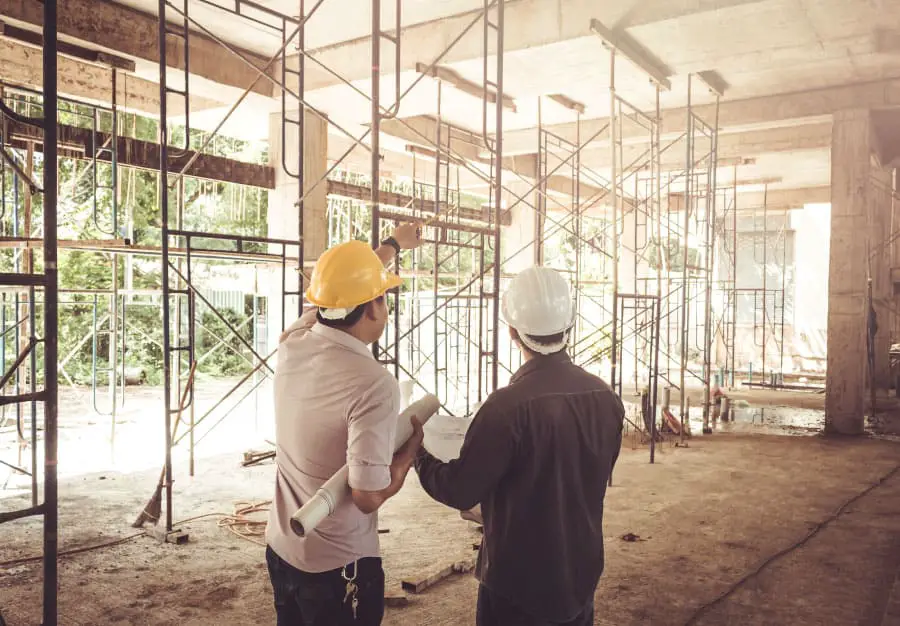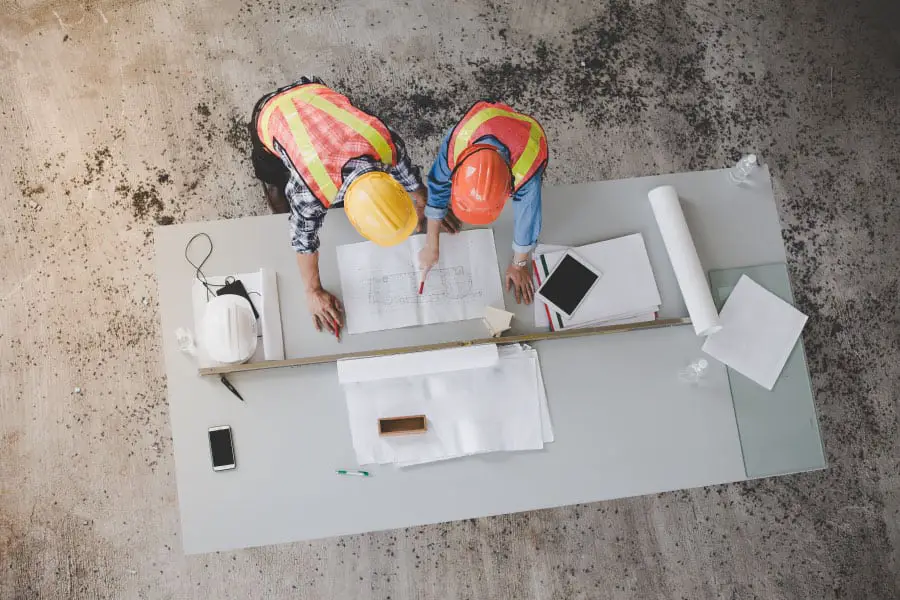Construction Manager vs. Architect: What’s the Difference?
Construction managers and architects are often the two main pillars of any construction project. There are many similarities and differences between the two that will require a client to have an entirely different thought process when communicating with them.
With so many professionals working together on a building, it can get confusing on who does what sometimes and who has the final say in things.
A construction manager is in charge of all the logistics and manpower needed to have the building built, while an architect is in charge of the planning of the building. Both professions are important to ensure that a project runs smoothly and is successful.
In this article, we’ll be going into the individual jobs and responsibilities of an architect and construction manager, their similarities and differences, and how the client should interact with each of these professionals.
What does an architect do?
The main job of the architect is to plan the building and, to some extent, the site itself. Their vast knowledge and skill set allow them to create building plans down to the smallest details.
Architects create plans, models, diagrams, and specifications to communicate and show what a building will look like and how it will be built.
The biggest challenge that an architect faces in any project is to come up with creative solutions that are both practical and aesthetically pleasing. Unfortunately, these two aspects are often in conflict with one another. Famous building designs are often hard to maintain or to build, either because of their complexity or the design’s features.
The architect is also in charge of coordinating with different professionals from different fields to ensure that the planned building can function properly and for its intended use.
The architect has to work with the following professionals in order to fully plan a building for approval:
- Civil Engineer
- Master Plumber
- Electrical Engineer
- Mechanical Engineer
- Geodetic Engineer
- Building Official
- Client
- Landscape Architect
- Construction Manager
The amount of professionals that the architect needs to talk to is highly dependant on the scale and complexity of a project. The level of expertise of the architect will also be reflected by how well they can incorporate the recommendations of the professionals into a project. A good design should be easily understood and executed on by others.
What is an architect’s role during construction?
The architect needs to constantly check in on the project to see how everything is going along and as planned. Although it is the construction manager’s responsibility, it doesn’t hurt to always have an extra set of eyes on the project to see what could be done.
Since the architect knows the plans like the back of his/her hand, he/she would easily be able to tell if something is wrong and correct the problem before any other construction is done.
What does a construction manager do?
The construction manager is the one who will be providing the necessary materials and manpower to turn an architect’s plan into a reality.
The biggest challenge of the construction manager is to keep track of everything, as they have to follow each and every instruction from the architect, down to the letter. They must also be extremely knowledgeable about how everything will actually be built, on top of having the skill set to manage the logistics needed to have a building built.
Besides making sure that the building is built, construction managers have to always ensure that it is done in the most efficient and optimal way, without sacrificing the quality of the construction.
This is what separates construction managers from one another. Clients usually choose construction managers based on three factors, namely:
- Lowest-Price. A construction manager with the lowest proposed price for the project.
- Qualifications. A construction manager with a lot of experience in projects.
- Value. A construction manager who has both a lower price and experience in projects.
The bidding process is where the client decides and picks the construction manager for the project. Bids are the quotations that construction managers give to the client for the entire costing of the project. If the bid and the actual construction costs do not match, the construction manager will have to pay for the excess fees.
Some construction managers take advantage of this by intentionally setting a lower bid price and invest a bit of their money in order to get a client, which still comes out as a projected net income.
This practice may seem disingenuous, but it’s actually advantageous also for the client, as long as the materials used are of the prescribed quality, and the construction goes well since the costing is lower.

What is a construction manager’s role during construction?
The construction manager has to be on-site throughout the entire construction process to ensure that the project goes smoothly. They’ll be monitoring the laborers and, at the same time, will be making sure that there are actually enough materials and tools to get the job done.
To ensure that a project goes as efficiently and as optimal as possible, the construction manager will have to make sure that the following three things are in order, namely:
- Quality of work output
- Timeliness of work output
- Quality of materials used
It may look easy if you read it like that; however, this is just the general idea of what needs to be achieved and things are far more complex on any given project.
For example, timeliness of work output entails ensuring that the delivery of materials is on time, workers arrive on time, workers are getting the work done properly, construction vehicles arrive on time, etc.
Quality of work output will require the construction manager to constantly monitor what the construction workers are doing and will also include daily inspections.
A good and experienced construction manager always has to be on top of everything that goes on at the construction site and should always know what the next step is. Preparation and foresight is the name of the game to make sure all variables are accounted for.
Similarities between an architect and construction manager
Here are the similarities between an architect and construction manager:
| Architect | Construction Manager |
| Plans the entire building | Plans out how the construction will go |
| Communication with other professions | Communication with suppliers, workers, etc. |
| Payment based on progress | Payment based on progress |
Both professions require a lot of planning and a lot of communication. The architect has to communicate with a lot of professionals.
In every stage of the project, the architect has to constantly revise their plans to come up with the best solutions possible. They have to really pay attention to how their plans are made, as one misplaced line could possibly end up causing failure within the building.
The construction manager has to communicate in very steep detail with the architect, client, and construction workers. They need to make sure that the translation between the paper and the earth is as exact as it could possibly be by making sure that the construction workers are doing what they should be doing. It only takes one misplaced marker to displace the entire project completely.
Both professions are normally never paid in full. Instead, they are paid partially based on their progress on the project. There are other modes of payment; however, this usually is how it is done in the industry.
Differences between an architect and construction manager
Here are the differences between an architect and construction manager:
| Architect | Construction Manager |
| Visionary/Idealistic Mindset | Realistic/Efficient Mindset |
| Creation of buildings | Creation and destruction of buildings |
| Manages plans | Manages logistics and people |
The main difference between the two professions would be the thinking and mindset that they have when going into a project.
The architect can be described as the visionary, creating and working with ideas to see what would work and wouldn’t while at the same time, ensuring that this vision serves the needs of the client. The creative solutions, designs, and forms that the architect provides are based on the needs of the client.
The construction manager is the realist. They do not see a vision in a project; instead, they have to see a construction project from a completely practical perspective. Although they do not have a say in the plans, the construction manager still has to inform the client if an idea is too expensive or inefficient to build.
As stated earlier, the main objective of the construction manager is to complete the project in the most efficient and optimal way by, in simpler terms, giving clients the best value for their money.
Another big difference between the two professions is that the architect is purely for creation, restoration, and renovation. At the same time, the construction manager is also a part of those aspects of buildings as well as demolition.

Who’s at fault if something goes wrong?
In the simplest terms, whenever something goes wrong with a building, someone is going to have to take the blame and be liable for the cost of the failure.
The person liable depends on what caused the failure. There is a big difference between building failure and building damage. The latter is caused by external forces, while internal forces usually cause the former. Insurance policies usually only cover building damage from fires, earthquakes, etc., while building failure should be covered by the person/s liable.
For example, a building begins to fail structurally. It can either be due to the miscalculations of the civil engineer, a mistake in the drawings of the architect, or an incorrect construction method used by the construction manager.
Cases like these are often investigated by an independent third party, usually the building official, in order to determine what the real cause of the structural failure was.
There are some cases where the building is structurally wrong because of the client. An example of this would be the Sampoong Department Store, which was caused by numerous factors such as ignoring proper planning as well as the misuse of the building’s intended purpose.
“The Sampoong Department Store is a cautionary tale on what happens when building owners completely ignore the professional advice of the architect and engineer. Lee Joon, who owned a construction company, decided to keep on constructing and making changes to the original building plans despite being fully aware that the building was not planned to handle any of the additional loads to be added.
Lee decided to intentionally reduce the number of columns, further spaced them apart to maximize space, and added an extra floor, which resulted in a total collapse of the building only 5 years later.”
If a dispute comes up between an architect, client, or construction manager, it is either mediated by a third party, legal representation, or arbitration. Disputes can range from costing, design, or payment, and the type of dispute is conducted based on the severity of the case.
Client, Architect and Construction Manager
Clients, from the start, should trust the professionals that they are working with and should believe that they have their best interest in mind. Bear in mind that the client should always pay attention and be up to date as to what’s happening throughout the duration of the project.
The best way is to ask for weekly reports from both the architects and the construction manager. This is to ensure that the project is going well and as planned. The client should also check in from time to time to ensure that the reports are accomplished.
Knowing who should be held accountable for what is also important when going into a construction project. If something is amiss or not up to the client’s standards, they should be able to immediately tell whoever is in charge of that aspect to correct it.

What does a building official do?
The client, architect, and construction manager all answer to the building official. The building official is in charge of making sure that everything in the project is done right and in accordance with the government’s law, provisions, and standards.
The building official must approve the important aspects of the building, from design to construction to final output.
The laws for buildings are made in order to ensure that all buildings can coexist with each other harmoniously and with the rest of the environment. Even during construction, there is a correct procedure in how things should be done.
For example, if your lot is under construction, you must ensure that there is always a barrier between the lot and the sidewalk to protect the street and the sidewalk. If your construction affects a sidewalk, you must provide a way for people to still be able to walk to where they need to go.
Nothing can be built without the approval of a building official.
Any structures made without supervision and approval will most likely result in either demolition or heavy penalties, as structures are what define the environment in highly urbanized areas. Imagine if a skyscraper was built in the middle of a subdivision, or if a power plant was built right beside a school.
The government is there to ensure that all the structures are up to a standard to protect and promote the safety and wellbeing of people.
Conclusion
The architect and the construction manager are the two main people that the client will be talking to in a construction project. Knowing what their responsibilities are and what is within the range of their expertise provides the client with better knowledge and understanding of how they should move forward during a project.
The end goal of all construction projects is to create a building that is well designed, functional, and aesthetically beautiful while at the same time ensuring that it is built in the most efficient, cost-effective, optimal, and timely manner possible.







